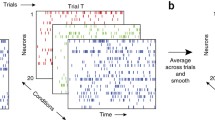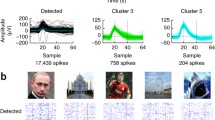Abstract
We report a morphology-based approach for the automatic identification of outlier neurons, as well as its application to the NeuroMorpho.org database, with more than 5,000 neurons. Each neuron in a given analysis is represented by a feature vector composed of 20 measurements, which are then projected into a two-dimensional space by applying principal component analysis. Bivariate kernel density estimation is then used to obtain the probability distribution for the group of cells, so that the cells with highest probabilities are understood as archetypes while those with the smallest probabilities are classified as outliers. The potential of the methodology is illustrated in several cases involving uniform cell types as well as cell types for specific animal species. The results provide insights regarding the distribution of cells, yielding single and multi-variate clusters, and they suggest that outlier cells tend to be more planar and tortuous. The proposed methodology can be used in several situations involving one or more categories of cells, as well as for detection of new categories and possible artifacts.






Similar content being viewed by others
Notes
The software DONE (Detection of Outlier NEurons) is an implementation for MATLAB that is available on our web-site (http://www.biological-networks.org/p/outliers/).
References
Ascoli, G. A. (Ed.) (2002). Computational neuroanatomy: Principles and methods. Totawa, NJ: Humana Press.
Ascoli, G. A., Donohue, D. E., & Halavi, M. (2007). Neuromorpho.org: A central resource for neuronal morphologies. Journal of Neuroscience, 27(35), 9247.
Binzegger, T., Douglas, R. J., & Martin, K. A. (2005). Axons in cat visual cortex are topologically self-similar. Cereb Cortex, 15(2), 152–165.
Botev, Z. I., Grotowski, J. F., & Krose, D. P. (2010). Kernel density estimation via diffusion. The Annals of Statistics, 38(5), 2916.
Cajal, S. R. (1989). Recollections of my life. Massachussetts: MIT Press.
Cook, J. E. (1998). Getting to grips with neuronal diversity: What is a neuronal type? In L. Chalupa & B. Finlay (Eds.), Development and organization of the retina (pp. 91). New York: Plenum.
Costa, L. da F., Manoel, E. T. M., Faucereau, F., Chelly, J., van Pelt, J., & Ramakers, G. (2002). A shape analysis framework for neuromorphometry. Network: Computation in Neural Systems, 13(3), 283.
Costa, L. da F., Rodrigues, F. A., Hilgetag, C. C., & Kaiser, M. (2009). Beyond the average: Detecting global singular nodes from local features in complex networks. Europhysics Letters, 87, 18008.
Costa, L. da F. & Velte, T. J. (1999). Automatic characterization and classification of ganglion cells from salamander retina. Journal of Comparative Neurology, 404, 33.
Costa, L. da F., Zawadzki, K., Miazaki, M., Viana, M. P., & Taraskin, S. N. (2010). Unveiling the neuromorphological space. Frontiers in Neuroscience, 4, 1.
Donohue, D. E., & Ascoli, G. A. (2010). Automated reconstruction of neuronal morphology: An overview. Brain Research Review, 67,(1–2), 165.
Eadie, W. T., Drijard, D., James, F. E., Roos, M., & Sadoulet, B. (1971). Statistical methods in experimental physics. North-Holland, Amsterdam.
Echtermeyer, C., Costa, L. da F., Rodrigues, F. A., & Kaiser, M. (2011). Automatic network fingerprinting through single-node motifs. PLoS ONE, 6(1), 9.
Echtermeyer, C., Han, C. E., Rotarska-Jagiela, A., Mohr, H., Uhlhass, P., & Kaiser, M. (2011). Integrating temporal and spatial scales: Human structural network motifs across age and region of interest size. Frontiers in Neuroinformatics, 5, 14.
Gleeson, P., Steuber, V., & Silver, R. A. (2007). Neuroconstruct: A tool for modeling networks of neurons in 3D space. Neuron, 54(2), 219.
Halavi, M., Polavaram, S., Donohue, D. E., Hamilton, G., Hoyt, J., Smith, K. P., et al. (2008). Neuromorpho.org implementation of digital neuroscience: Dense coverage and integration with the NIF. Journal of Neuroinformatics, 6(3), 241–252.
Härdle, W. K., & Simar, L. (2007). Applied multivariate statistical analysis (2nd ed.). Springer.
Kaiser, M., & Hilgetag, C. C. (2006). Nonoptimal component placement, but short processing paths, due to long-distance projections in neural systems. PLoS Computational Biology, 7(95), 806.
Kaiser, M., Hilgetag, C. C., & van Ooyen, A. (2009). A simple rule for axon outgrowth and synaptic competition generates realistic connection lengths and filling fractions. Cerebral Cortex, 19(12), 3001.
Loewi, O. (1921). Über humorale Übertragbarkeit der Herznervenwirkung. Pflügers Archiv, 189, 239.
Loewi, O. (1955). Salute to Henry Hallet Dale. The British Medical Journal, 1(4926), 1356.
Lu, J., Fiala, F. C., & Lichtman, J. W. (2009). Semi-automated reconstruction of neural processes from large numbers of fluorescence images. PLoS ONE, 4(5), e5655.
McGhee, G. R. (2006). The geometry of evolution: Adaptive landscapes and theoretical morphospaces. Cambridge University Press.
Montague, P. R., & Friedlander, M. J. (1991). Morphogenesis and territorial coverage by isolated mammalian retinal ganglion cells. Journal of Neuroscience, 11, 1440.
Poznanski, R. R. (1992). Modelling the electronic structure of starburst amacrine cells in the rabbit retina: Functional interpretation of dendritic morphology. Bulletin of Mathematical Biology, 54, 905.
Schierwagen, A. (2008). Neuronal morphology: Shape characteristics and model. Neurophysiology, 40(4), 310.
Scorcioni, R., Polavaram, S., & Ascoli, G. A. (2008). L-measure: A web-accessible tool for the analysis, comparison and search of digital reconstructions of neuronal morphologies. Nature Protocols, 3, 866.
Sholl, D. A. (1953). Dendritic organization in the neurons of the visual and motor cortices of the cat. Journal of Anatomy, 87, 387.
Sporns, O., Chialvo, D. R., Kaiser, M., & Hilgetag, C. C. (2004). Organization, development and function of complex brain networks. Trends in Cognitive Sciences, 8(9), 418.
Srinivasan, R., Zhou, X., Miller, E., Lu, J., Litchman, J., & Wong, S. T. C. (2007). Automated axon tracking of 3D confocal laser scanning microscopy images using guided probabilistic region merging. Neuroinformatics, 5(3), 189.
Stepanyants, A., & Chklovskii, D. B. (2005). Neurogeometry and potential synaptic connectivity. Trends in Neuroscience, 28(7), 387.
Stepanyants, A., Hof, P. R., & Chklovskii, D. B. (2002). Geometry and structural plasticity of synaptic connectivity. Neuron, 34(2), 275.
Toris, C. B., Eiesland, J. L., & Miller, R. F. (1995). Morphology of ganglion cells in the neotenous tiger salamander retina. Journal of Comparative Neurology, 352(4), 535.
Wen, Q., & Chklovskii, D. B. (2008). A cost-benefit analysis of neuronal morphology. Journal of Neurophysiology, 99, 497.
Acknowledgements
Luciano da F. Costa is grateful to FAPESP (05/00587-5) and CNPq (301303/06-1 and 573583/2008-0) for sponsorship. Krissia Zawadzki is grateful to FAPESP sponsorship (2010/01994-1). Matheus P. Viana is grateful to FAPESP sponsorship (2010/16310-0). Marcus Kaiser and Christoph Feenders acknowledge support by EPSRC (EP/G03950X/1) and the CARMEN e-science Neuroinformatics project ( http://www.carmen.org.uk ) funded by EPSRC (EP/E002331/1). Marcus Kaiser is also funded through the WCU program of the National Research Foundation of Korea funded by the Ministry of Education, Science and Technology (R32-10142).
Conflict of interests
The authors declare that the research was conducted commercial or financial relationships that could be construed as a potential conflict of interest.
Author information
Authors and Affiliations
Corresponding authors
Rights and permissions
About this article
Cite this article
Zawadzki, K., Feenders, C., Viana, M.P. et al. Morphological Homogeneity of Neurons: Searching for Outlier Neuronal Cells. Neuroinform 10, 379–389 (2012). https://doi.org/10.1007/s12021-012-9150-5
Published:
Issue Date:
DOI: https://doi.org/10.1007/s12021-012-9150-5




